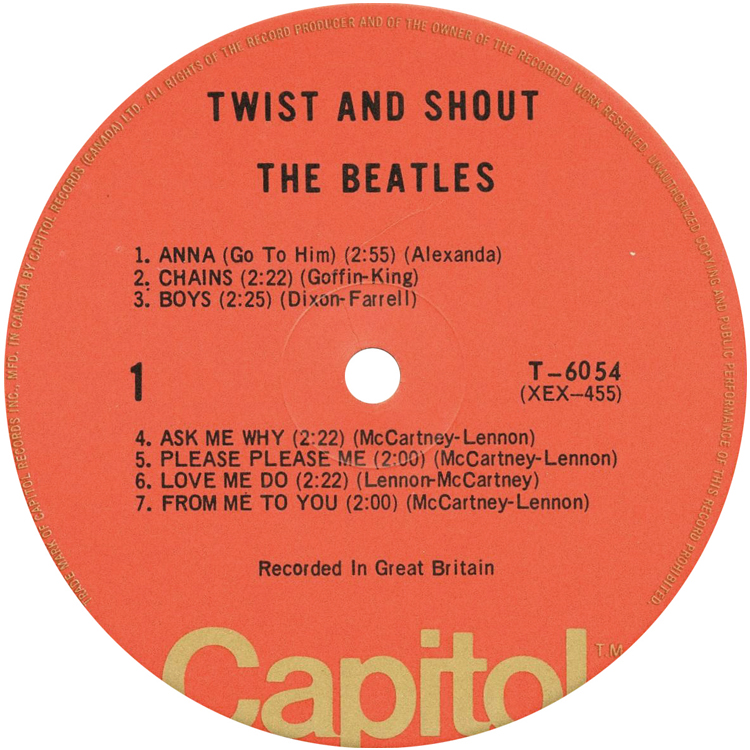← Twist And Shout Variations List
Twist And Shout
This album was a unique Canadian release
LP.6054.6.2 | Orange 1st Generation, Dynaflex pressing
Variation LP.6054.6.2 was released only in MONO. This pressing is recognized by its gold perimeter print and new type of RCA pressing with a small 24 mm pressing ring similar to Compo pressing rings (that are 25 mm). Dynaflex technology used a more flexible vinyl compound that was said to be "more forgiving", and where records could be pressed thinner.
This technology would apparently allow the grooves to "preserve their shape" more easily after repeated use (this claim has not been verified and the technology was "hit and miss", with fantastic pressings on some occasions, while others were wobbly and would curve easily when the shrink wrap was too tight and the record kept in conditions where the temperature was too high).


Availability
This variation was available primarily in or around 1973 (for approximately 1 year) before the label design featured a black perimeter text (see LP.6054.7.1).
General Information
This pressing is also more difficult to find today, and was soon replaced with the newer labels with black perimeter text in 1974. First generation orange labels are the rarest of all three generations, as very few copies were pressed at the time (low demand). Notice that first generation labels only have a ™ logo, since the ® logo appeared only in January 1975, under the 2nd generation orange labels.
Capitol of Canada most likely subcontracted the RCA pressing plant in Smith Falls (Ontario) one last time to manufacture new batches of albums, using once again its new Dynaflex technology. We say "most likely" because this pressing has an MCA marking on the trail off area, meaning this records is either a Compo (MCA) pressing, or the lacquer was prepared at MCA for unknown reasons. This album was never pressed by Compo before, so it would be surprising (and without logical explanation) that it would have been only this time around. The fact that Dynaflex and Compo pressing rings are almost identical complicates the assessment process, but the authors believe that the lacquer was probably prepared at MCA (only available provider?), and that the records were nonetheless pressed at RCA:
Side A: XEX-455-2 ◎--O--◎
Side B: XEX-456

RCA's new Dynaflex technology
RCA's "Dynaflex" technology, introduced in the 1970s, was an innovative approach to manufacturing vinyl records. Dynaflex records were significantly thinner and more flexible than standard vinyl records of the time. RCA developed this technology in response to several issues with traditional records, including warping, breakage, and the cost of materials. Specifically:
Material and Thickness: Dynaflex records were made from a specially formulated vinyl that allowed them to be pressed thinner than conventional records. While standard vinyl records were around 120-150 grams, Dynaflex records typically weighed between 90-110 grams.
Flexibility: One of the most notable features of Dynaflex records was their flexibility. They could be bent and flexed without breaking, which made them more durable and less prone to warping.
Cost Efficiency: The thinner vinyl used in Dynaflex records reduced production costs. This was advantageous for RCA, allowing them to save on materials and shipping due to the reduced weight.
Sound Quality: While Dynaflex records were praised for their durability, there was some controversy regarding their sound quality. Audiophiles and critics often debated whether the thinner vinyl affected the audio fidelity. Some felt that Dynaflex records had less dynamic range and were more prone to surface noise.
The reception to Dynaflex was mixed. While some consumers appreciated the durability and lower cost, others preferred the traditional, heavier vinyl records for their perceived superior sound quality and tactile feel. Despite the mixed reviews, Dynaflex represented an interesting chapter in the history of vinyl record production, highlighting the industry's efforts to innovate and adapt to changing market conditions and technological advancements.
ALSO OF NOTE
The Dynaflex pressings with the smaller pressing ring were officially introduced in the Beatles catalogue around 1972-1973, but some earlier pressings with the traditional large RCA groove were found in the previous few years with a softer compound (e.g. Late rainbows, target labels and early orange label pressings). It is believed that RCA was experimenting with different vinyl compositions before officially introducing their new approach.
Cover
The cover of this variation is identical to the previous variation (LP.6054.6.1), printed by Parr's Litho, with a straight inner seam construction measuring approximately 7 mm.

Early copies can be found with the lighter shade of pink (left: regular cover, right: LP.6054.6.2 cover). It seems that the batch of Parr's covers with a lighter shade of pink produced in the late 1960s was still in stock by 1973, and were used until the warehouse needed to be re-stocked with new covers.

Otherwise, the cover construction is identical to all previous variations. This is one of the last variations to use a traditional front slick construction.

Packaging
This edition was shipped in tight shrink wrap, with or without a plain paper LP inner sleeve. These Capitol sleeves are square and have a slight curve at the top. Note** These inner sleeves were being used as they refilled stocks, so it is possible that leftover earlier sleeves were used as well.
